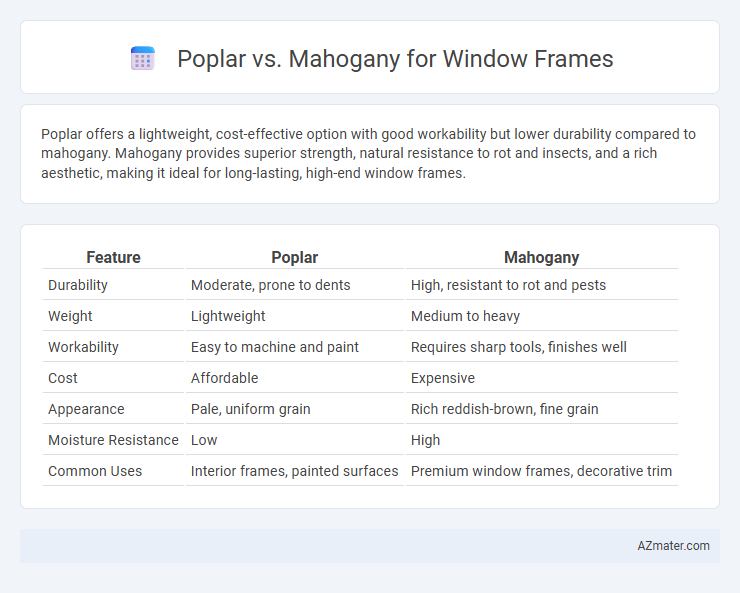Poplar offers a lightweight, cost-effective option with good workability but lower durability compared to mahogany. Mahogany provides superior strength, natural resistance to rot and insects, and a rich aesthetic, making it ideal for long-lasting, high-end window frames.
Table of Comparison
| Feature | Poplar | Mahogany |
|---|---|---|
| Durability | Moderate, prone to dents | High, resistant to rot and pests |
| Weight | Lightweight | Medium to heavy |
| Workability | Easy to machine and paint | Requires sharp tools, finishes well |
| Cost | Affordable | Expensive |
| Appearance | Pale, uniform grain | Rich reddish-brown, fine grain |
| Moisture Resistance | Low | High |
| Common Uses | Interior frames, painted surfaces | Premium window frames, decorative trim |
Introduction to Poplar and Mahogany for Window Frames
Poplar offers a lightweight, cost-effective option for window frames with its fine, even grain and smooth texture, making it easy to paint and finish. Mahogany is prized for its rich, reddish-brown color and exceptional durability, providing natural resistance to rot and insects ideal for long-lasting window frames. Both woods balance aesthetics and functionality, with poplar suitable for budget-conscious projects and mahogany favored for premium, high-end applications.
Key Characteristics of Poplar Wood
Poplar wood is lightweight and moderately soft, making it easy to work with for window frames, while its pale, creamy color provides a neutral base that accepts paint and stain well. It offers moderate durability and stability but is less resistant to moisture and decay compared to mahogany, requiring proper sealing for exterior use. Poplar is also more affordable and widely available, making it a cost-effective choice for interior window frames.
Essential Properties of Mahogany Wood
Mahogany wood boasts exceptional durability, natural resistance to decay, and a fine, even grain that enhances its aesthetic appeal for window frames. Its dimensional stability minimizes warping and swelling, ensuring long-lasting performance in varying weather conditions. These essential properties make mahogany a premium choice compared to poplar, which is softer and less resistant to moisture and wear.
Durability Comparison: Poplar vs Mahogany
Mahogany is significantly more durable than poplar for window frames due to its high resistance to decay, pests, and moisture, making it ideal for long-lasting exterior applications. Poplar, while easier to work with and more affordable, lacks the natural hardness and weather resistance found in mahogany, leading to a shorter lifespan when exposed to outdoor conditions. Choosing mahogany ensures enhanced structural integrity and minimal maintenance over time despite its higher initial cost.
Aesthetic Differences: Grain, Color, and Finish
Poplar window frames exhibit a fine, straight grain with a pale, creamy color that accepts paint very well, making them ideal for versatile aesthetic finishes. Mahogany offers a rich, deep reddish-brown hue with a pronounced, interlocking grain pattern that enhances natural wood aesthetics and stains beautifully for a luxurious finish. The choice between the two depends on whether a painted, smooth look (poplar) or a warm, elegant, natural wood appearance (mahogany) is preferred for the window frame.
Workability and Installation Ease
Poplar wood offers superior workability for window frames due to its uniform texture and softness, making it easy to cut, shape, and paint with minimal effort. Mahogany, while denser and harder, provides excellent durability but requires more specialized tools and skill for precise installation, potentially increasing labor time. The ease of installation favors poplar for DIY projects and quick assembly, whereas mahogany suits professional applications where long-term resilience is prioritized.
Cost Analysis: Poplar vs Mahogany
Poplar is significantly more cost-effective than mahogany for window frames, with prices typically ranging from $2 to $5 per board foot compared to mahogany's $12 to $20 per board foot. The lower cost of poplar makes it an attractive option for budget-conscious projects without compromising moderate durability. While mahogany offers superior resistance to moisture and decay, its higher upfront cost often limits its use to premium window frames or high-end architectural applications.
Environmental Impact and Sustainability
Poplar window frames offer a lower environmental impact due to their rapid growth and renewable nature, making them a sustainable choice for eco-conscious construction. Mahogany, although prized for its durability and rich appearance, often comes from slower-growing tropical trees, raising concerns about deforestation and habitat loss. Sustainable sourcing certification such as FSC for mahogany can mitigate environmental risks, but poplar remains a more naturally renewable option with minimal ecological footprint.
Best Applications for Each Wood Type
Poplar is best suited for interior window frames due to its lightweight nature, fine grain, and ease of painting, making it ideal for rooms where cost-efficiency and paint finish quality are prioritized. Mahogany excels in exterior window frames because of its natural durability, resistance to rot and insect damage, and rich, deep color that enhances curb appeal and withstands harsh weather conditions. Selecting mahogany or poplar depends on application priorities such as environmental exposure, budget, and aesthetic preferences.
Final Verdict: Choosing Between Poplar and Mahogany
Poplar offers an affordable, lightweight, and easily paintable option ideal for interior window frames, while mahogany stands out with superior durability, natural resistance to rot, and rich aesthetic appeal suitable for high-end or exterior window frames. Mahogany's dense grain and stability make it the preferred choice for long-lasting, premium finishes, whereas poplar requires protective coatings to enhance its longevity but excels in cost-effectiveness and workability. Selecting between poplar and mahogany ultimately depends on budget constraints, desired durability, and aesthetic goals for the window frame project.

Infographic: Poplar vs Mahogany for Window Frame
 azmater.com
azmater.com